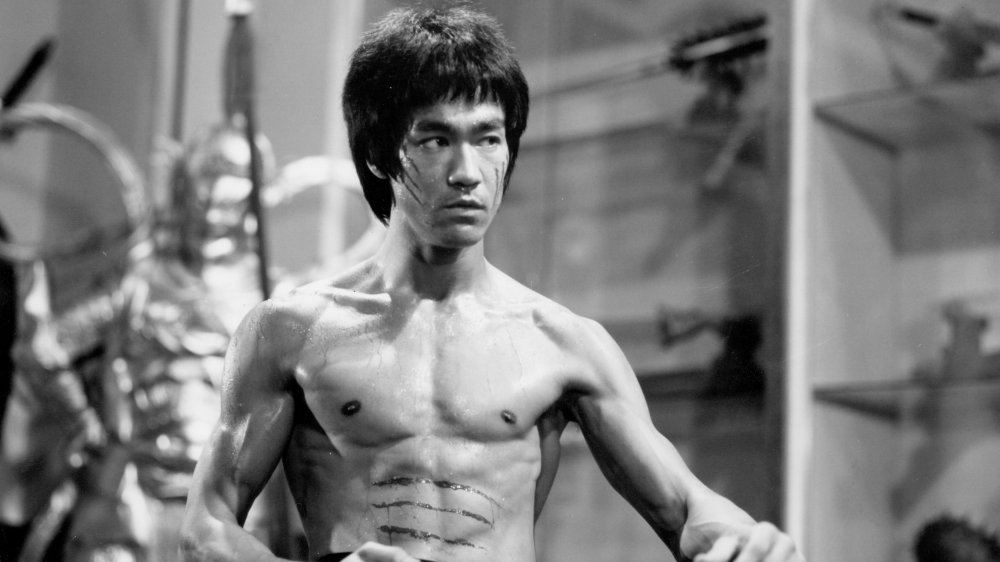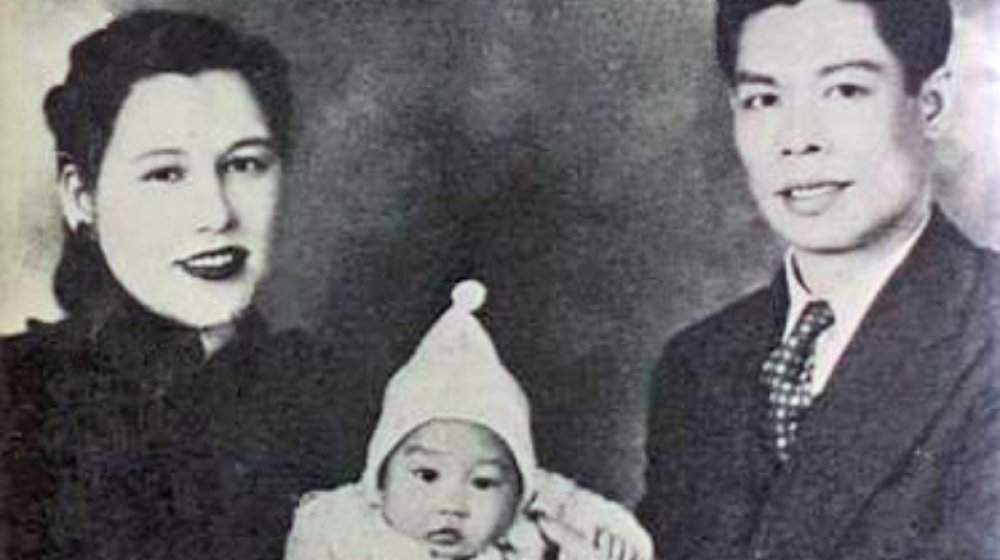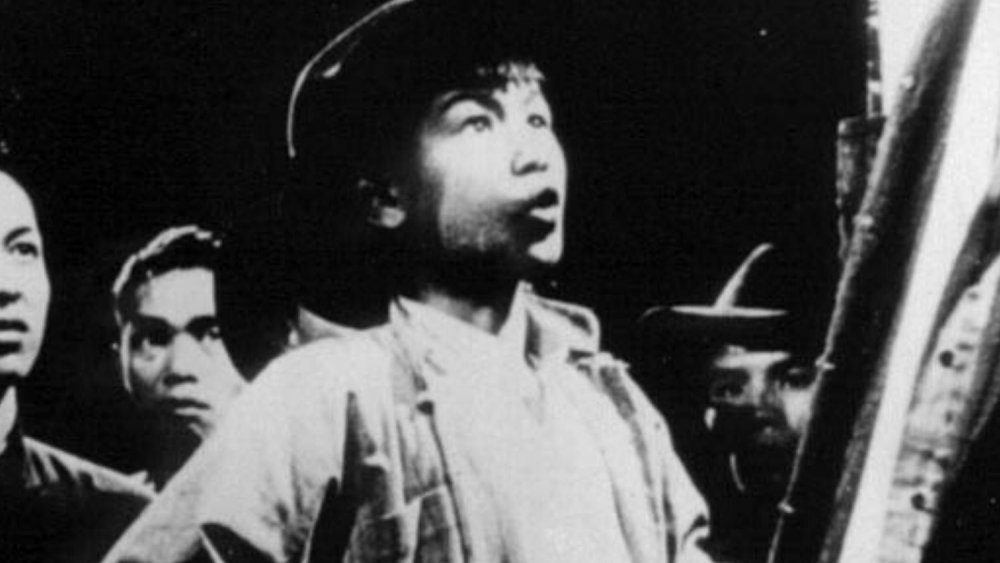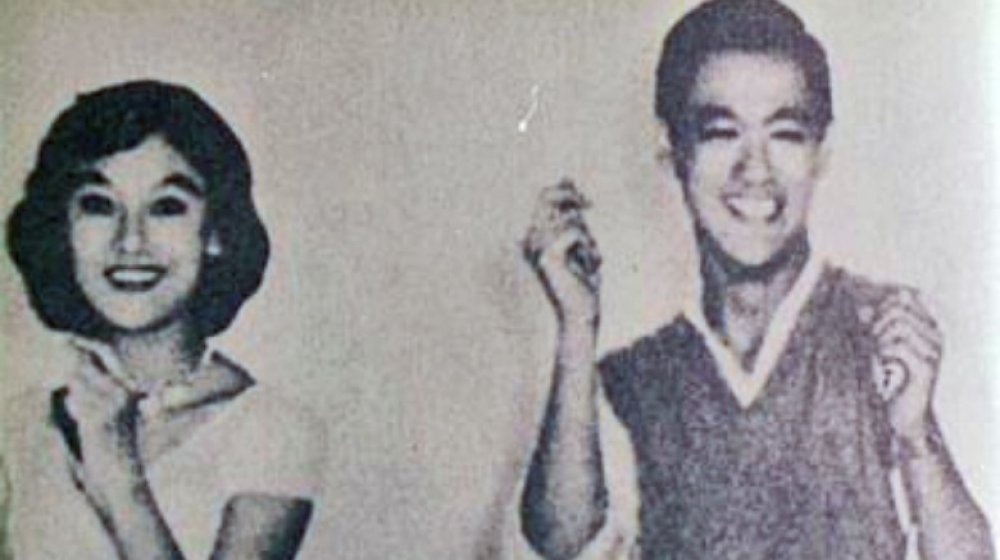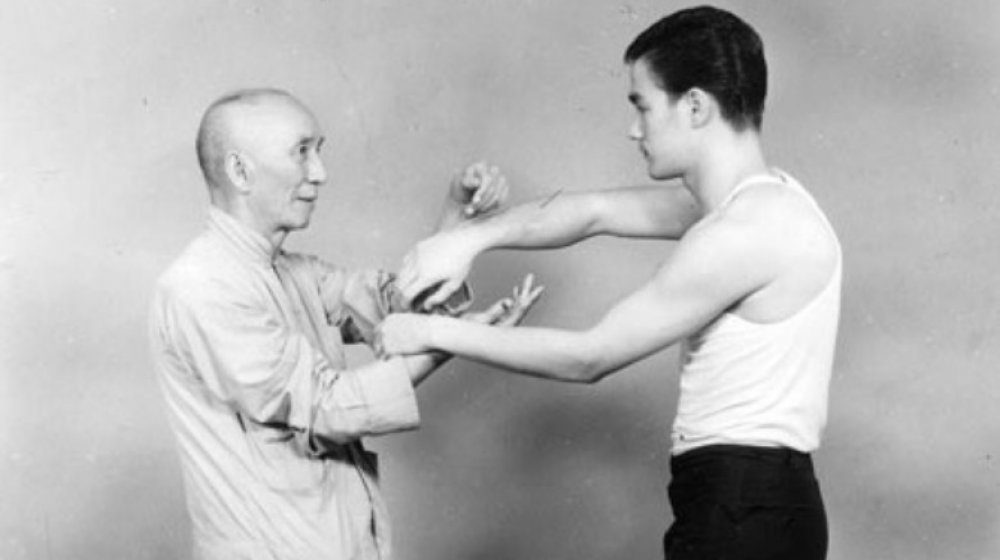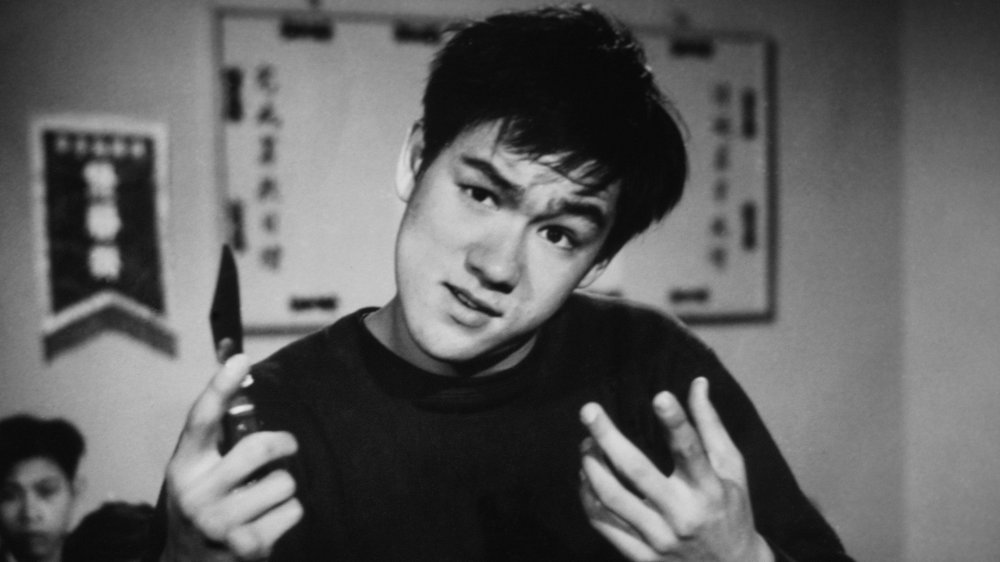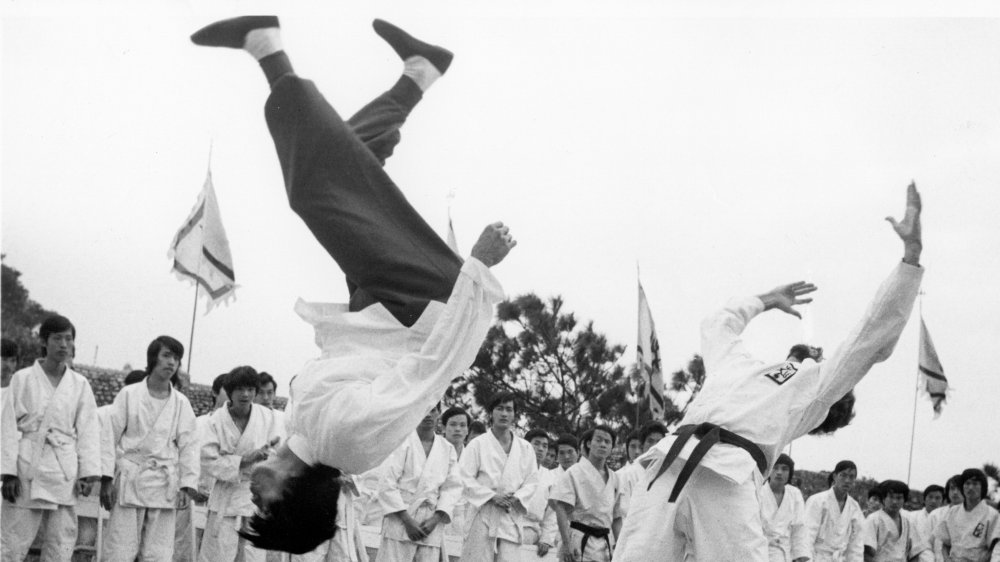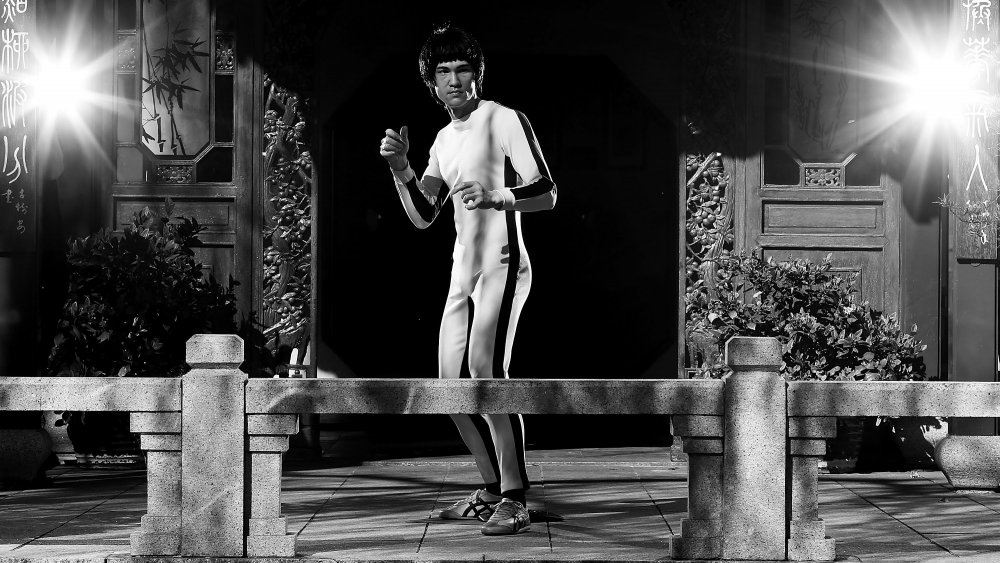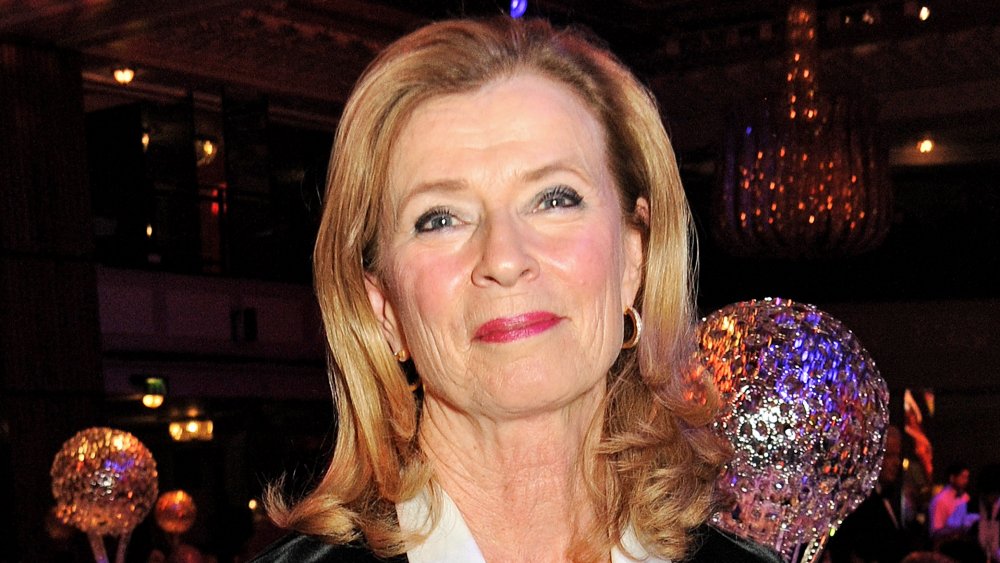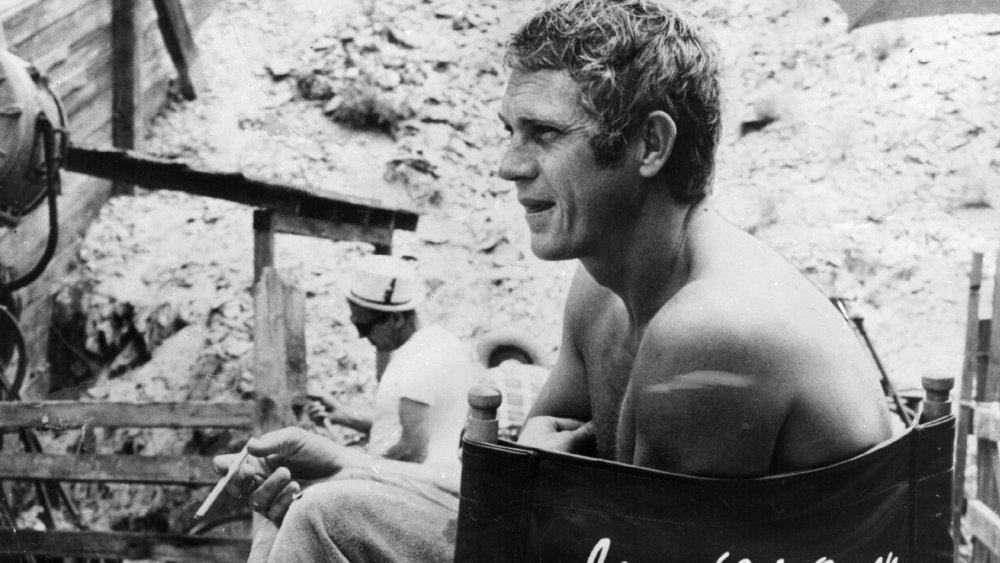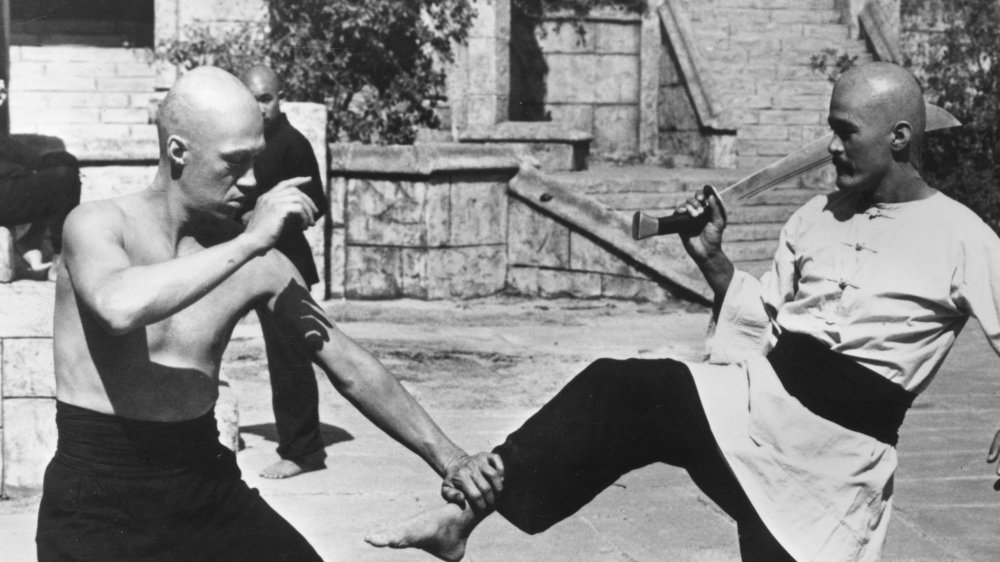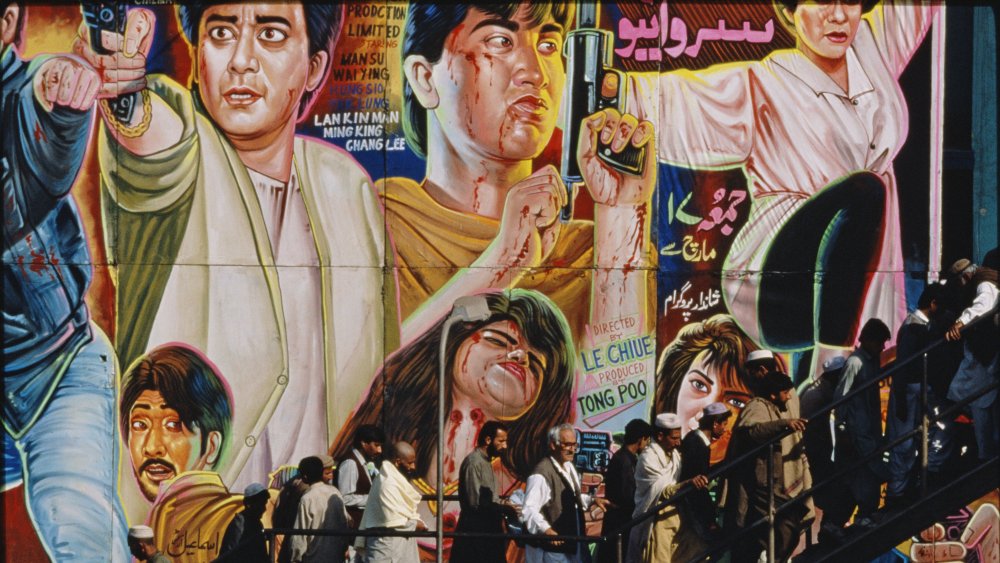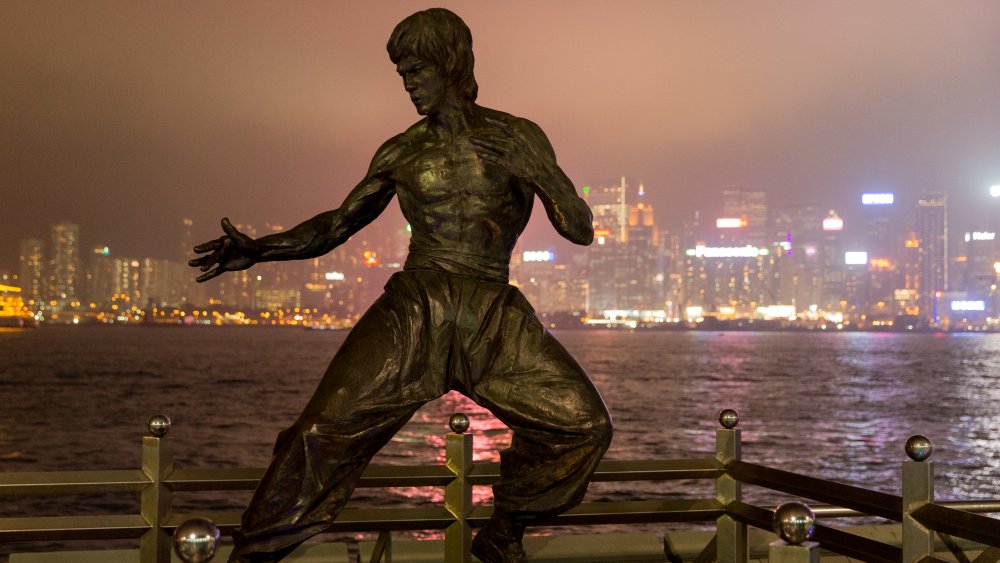Times Dragon: The Bruce Lee Story Movie Lied To You
We may receive a commission on purchases made from links.
Bruce Lee is an icon — a legendary martial arts master who still has an incredible cult following. While he is credited with jump-starting the martial arts craze in the United States during the 1970s, he is still revered as an inspiration to martial arts enthusiasts and hobbyists today. Lee is remembered as a teacher, an actor, a writer, and a philosopher, and he met his end far too soon. After his strange and shockingly premature death at the age of 32, Lee is still a source of utter fascination.
There have been quite a few biopics about the life and death of Bruce Lee, but the most famous one would have to be the 1993 film Dragon: The Bruce Lee Story. The movie stars Jason Scott Lee (no relation) as Bruce Lee and Lauren Holly as his wife, Linda. While this is undoubtedly the most prominent Bruce Lee biopic, the film definitely takes significant liberties with the details of Lee's life. Here are a few of the times when Dragon: The Bruce Lee Story lied to you.
Bruce Lee wasn't 100-percent Chinese
Bruce Lee was proud of his Chinese heritage, but his background was actually quite multicultural. Lee's mother was Grace Ho, a member of a prestigious and affluent Eurasian family. In an interview with Inkstone News, Bruce Lee's biographer, Matthew Polly, discovered that Lee's great-grandfather was actually born in the Netherlands and that his maternal grandfather appeared to have had an affair with a British woman — making Bruce one-quarter English, one-eighth Dutch-Jewish and five-eighths Chinese. According to Vice, Lee's mother, Grace, eloped with his father, Lee Hoi Chuen, a Chinese opera singer, much to the horror of her family. Grace accompanied her husband on his tour with the Cantonese Opera and served as a wardrobe manager. It was during one of Hoi Chuen's tours in America that Bruce Lee was born in San Francisco — giving baby Bruce American citizenship. Bruce also wasn't an only child as he appeared in the film — he was one of five children. (An older brother died in infancy).
Although Lee had a rich and cultured background, it wasn't entirely beneficial when he started studying kung fu in Hong Kong. The young Bruce studied under the renowned master Ip Man, but many of his fellow students didn't support Bruce receiving instruction since he wasn't full-blooded Chinese. The oft-mentioned rule in The Bruce Lee Story about non-Chinese not being allowed kung fu (or gung fu) instruction was real but would eventually fade out.
Bruce Lee wasn't discovered in America
From watching the movie, it would be easy to believe that Bruce Lee didn't get his big break in entertainment until he came to the United States. Not so. Coming from a family of industry veterans, Bruce already had plenty of experience in film acting long before he landed in America. According to Biography, he had his first onscreen role at the age of three months when he acted as the stand-in for an American baby in the 1941 film Golden Gate Girl. From 1946 onward, Lee appeared in over 20 Chinese films as a child actor.
His early acting credits include The Kid, In The Face of Demolition, An Orphan's Tragedy, The Thunderstorm, and The Orphan. His biggest break in American entertainment culture would come when he played the role of Kato in the short-lived TV series The Green Hornet. While he was a well-known actor in China, Lee would only cement his place in American pop culture history after the posthumous release of the film Enter The Dragon.
Bruce Lee came from an affluent family
In the beginning of Dragon: The Bruce Lee Story, we see the young Bruce living with his father in a shabby little apartment in Hong Kong. They appear to be living in near-poverty. In reality, the exact opposite was true — the Lee family was quite wealthy. According to a CNN interview with Matthew Polly, the author of Bruce Lee: A Life, the Lees had a nice home with a chauffeur and two live-in maids — a far cry from the run-down flat we saw in the biopic.
When the Lee family sent young Bruce to the United States to keep him out of trouble, they didn't even send him overseas alone to make his way — he went to live with family friends. He was a dishwasher in a Chinese restaurant, but the restaurant belonged to the family friend, Ruby Chow (and Bruce was never involved in a violent kitchen fight with the restaurant staff). In fact, unlike in the film, Lee never arrived in America as a ship passenger in steerage. He was upgraded to first class after he started giving cha-cha lessons to ship passengers, as Lee was also a renowned cha-cha dancing champion in Hong Kong. (He won the Crown Colony Cha-Cha Championship in 1958.)
Bruce Lee was In a street gang
The movie showed the young Bruce Lee leaving Hong Kong after beating up a few British sailors, which isn't exactly what happened. As previously noted, the Lee family was quite wealthy, and the young Bruce attended an affluent private school. Hong Kong was still under British rule at the time, so Lee's school was comprised of both the children of Hong Kong's elite families and the children of the British upper crust. According to Newsweek, Lee and his fellow Chinese classmates were bullied by British students. In retaliation, Lee formed his own gang called the Junction Street Eight Tigers.
As further reported by Newsweek, Lee later recounted his street gang days in a 1967 interview with Black Belt magazine: "I was a punk and went looking for fights. We used chains and pens with knives hidden inside. Then, one day, I wondered what would happen if I didn't have my gang behind me if I got into a fight."
According to Lee, he was beaten very badly when an older student used a kung fu technique during a fight. This prompted Lee to begin his studies under the grand master Ip Man to avoid feeling helpless again. (Lee was 13 at the time, far older than when he was shown to have begun training in the film.) However, his lessons never did keep him completely out of trouble. After a run-in with the police, Lee was sent to America for a fresh start.
Bruce Lee never broke his back in a fight
One of the most eventful scenes in Dragon: The Bruce Lee Story takes place when Lee goes head-to-head with a kung fu master named Johnny Sun. When it looks as though Lee has won the fight and turns to depart, Sun attacks Lee from behind (in what is regarded as a dishonorable move) and subsequently breaks Lee's back. It's a memorable scene, but the actual story is far less intense. Lee never actually "broke" his back. He injured his back very severely, but it wasn't from a power struggle with another fighter. According to his official website, Lee hurt his back in 1969 during a routine exercise session due to not warming up properly beforehand.
The cause of the injury might sound fairly mundane, but the damage was no joke. The injury to his back was so severe that doctors told Lee that he could never practice martial arts again and might not even be able to fully walk properly. Lee was confined to his bed for almost a year, where he spent his time researching his injury. While he never "recovered" in the traditional sense, a combination of therapy and Lee's knowledge of kinesthetics and martial arts helped create a path to healing to the point where he was eventually able to go back to training and teaching.
Bruce Lee never fought Johnny Sun -- he didn't exist
In the film, we see Bruce Lee defending his right to teach kung fu to non-Chinese students by fighting Johnny Sun, who (fictionally) injured his back. Bruce later has his revenge by brutally defeating Sun in a tournament. This made for tension-driven storytelling, but Sun didn't exist — a martial arts master named Wong Jack Man did.
While the Chinese-only martial arts code was a real rule, that policy was dying off by the 1960s. The real reason for the fight? To put the nuanced situation simply, the fight happened as a result of Bruce Lee's trash talk. According to Vice, Lee was critical of other teachers' kung fu practices, deeming them "ineffective." Lee often liked to demonstrate existing practices and then explain why they wouldn't work. A particularly brutal lecture delivered at the Long Beach Tournament, during which Lee appeared highly condescending, raised the ire of many martial artists. Many challenged (and fought) Lee — and Wong Jack Man eventually became one of them.
There are a few theories explaining why Wong stepped up, but the likely one is that he wanted publicity for a new martial arts school he aspired to open. The fight between Lee and Wong took place behind closed doors with only nine people (including Lee and Wong) to witness the fight. The overall consensus was that the fight was rapid, intense, and raw, with Lee being the more aggressive and Wong more elusive. Lee ultimately pushed Wong into losing his footing, forcing him to yield.
Bruce Lee had other physical problems
By all accounts, Bruce Lee is widely regarded as a "kinetic genius," which Matthew Polly discusses in his recent biography. While Dragon: The Bruce Lee Story shows Lee's many struggles in overcoming his injured back, it never mentions that Lee had other significant physical issues aside from his back. These issues came to light after Lee was drafted into the US Army in 1963 and was ultimately rejected for service. As noted by HistoryNet, Lee failed his pre-induction physical and was classified as a 4-F ("not fit for military duty") when it was revealed that he had poor eyesight (he had switched from wearing glasses to contact lenses), a sinus disorder, and an undescended testicle.
While Lee was capable of mastering just about any form of martial arts, he had other physical limitations, such as never learning to swim, according to his siblings. (Contrary to popular myth, Lee was able to ride a bike, however.)
Bruce Lee's marriage wasn't quite so dramatic
Bruce Lee met his wife Linda Emery while they were attending the University of Washington, and Linda became a student at his kung fu school. The two were very much in love and married in 1964 — unusual for the time, as Bruce was Chinese and Linda was white. The movie did show Linda defying her racist mother and eloping with Lee, but according to Linda Lee Cadwell, her wedding day to Lee was a bit less dramatic. It was true that her family did not approve of her marrying outside of her race (Lee Cadwell stated that her mother particularly expressed concerns about her daughter facing hardships and discrimination), but Linda and Bruce did marry in a congregational church with Linda's mother and grandmother in attendance and a friend of Bruce's, Taky Kimura, serving as best man.
The film also never mentions that while Bruce and Linda married in 1964, their marriage wasn't accepted everywhere at the time. It wasn't just Linda's family that disapproved of their union — some state laws didn't approve, either. The Supreme Court wouldn't force all states to recognize interracial marriages until 1967.
Bruce Lee trained Hollywood stars
Bruce Lee really didn't have much onscreen fame in the United States until he starred in The Green Hornet and posthumously when Enter the Dragon was released, but he was doing amazing things behind the scenes. One aspect Dragon: The Bruce Lee Story never really covers is just how much of an impact Lee made on the sets by personally training many of Hollywood's biggest stars. Such actors who came under Lee's tutelage included Steve McQueen, James Coburn, Stirling Silliphant, Kareem Abdul-Jabbar, Sharon Tate, and Roman Polanski. Steve McQueen and James Coburn were actually pallbearers at Lee's funeral in 1973.
Another of Bruce Lee's famous Hollywood acquaintances was none other than the future action star Chuck Norris. While he never trained Norris, Lee and Norris did work together, and the two filmed a fight scene in the movie The Way of the Dragon. In an interview with Black Belt, Norris recalled working with Bruce with immense fondness and respect: "Bruce Lee learned from everybody. He had a very open mind. He never believed in only one martial arts style or that one was superior. He believed that everything had strengths and weaknesses and that we should find the strengths in each method."
Bruce Lee's TV show idea wasn't actually stolen
One major plot point in Dragon: The Bruce Lee Story dealt with Lee's struggles in the American entertainment industry. In one notable scene, Bruce Lee is shown discussing his idea to make a kung fu western TV show (starring himself) with a producer. Later, we see the show has been made, but with David Carradine in the starring role. It was heavily implied that the producer essentially stole Lee's original idea for the TV series, Kung Fu. But Lee never actually came up with the story — a Jewish comedy writer named Ed Spielman did. According to Martial Journal, Spielman had a passion for Asian culture and pitched a movie idea about a half-Chinese Shaolin monk wandering the American Old West righting wrongs with Eastern philosophy and kung fu. Warner Brothers executive Fred Weintraub took an interest in the script and wanted Bruce Lee as the star. However, Weintraub couldn't peak the enthusiasm of the studio heads, who were convinced that the American public wouldn't accept a Chinese hero.
Weintraub retooled the idea, making Kung Fu a weekly TV show. He presented the script to the Warner Brothers TV division and to ABC, who loved it. Lee was still Weintraub's first choice for the lead. Lee auditioned for the role, but studio heads complained that his accent couldn't be understood. After other Asian actors were auditioned and met with similar complaints, the white actor David Carradine was selected, and the character's Asian ancestry was minimized.
Bruce Lee's death spawned the Bruceploitation films
Although Bruce Lee only starred in five films as an adult, the impact he made on the film industry was remarkable. Lee can also be given significant credit for sparking the martial arts rage of the 1970s. Even after Bruce Lee's untimely death and the subsequent international success of his final movie, Enter The Dragon, Bruce Lee fervor didn't die down — if anything, it only increased. In fact, it could be said that Lee's fans weren't ready to let him go.
As described by Radio Times, what came after Lee's death was a slew of martial arts films that were later dubbed "Bruceploitation" films. Asian filmmakers still wanted to cash in on Lee's popularity, so they sought Bruce Lee lookalikes to star in martial arts films. Most of these Bruce "clones" were billed with similar names like "Bruce Ly," "Bruce Li," or "Bruce Leong." A typical Brucepolitation film usually highlighted tropes such as Lee's iconic yellow tracksuit, large sunglasses (to disguise the Bruce Lee impersonator's face), a Bruce Lee war cry, and a set of nunchaku. Some of the movies featured wildly bizarre (and often tasteless) plots such as The Dragon Lives Again, where "Bruce Lee" fights Dracula, James Bond, and Popeye in the depths of hell, or Bruce Lee Fights Back from the Grave, in which a Bruce Lee imitator literally pops out of his tomb after it gets struck by lightning.
Bruce Lee didn't die from a family curse
Throughout the film, we see Lee having nightmares of a strange demon — the result of a family curse. When the movie ends, Lee's death is revealed through Linda Lee's final narration that her husband died after slipping into "a mysterious coma" on July 20, 1973. Lee's premature death was startling but not terribly mysterious. There have been many conspiracy theories around Bruce Lee's death, but the cause was ruled as cerebral edema, a swelling of the brain that appeared to have been caused by an allergic reaction to a painkiller.
However, Matthew Polly suggests that heatstroke may have played a role in Lee's brain swelling. Polly notes that Lee collapsed from heatstroke three months earlier after working in a hot editing room with no air conditioning. He had been sleeping and eating less. The sweat glands in his underarms had been removed, as Lee disliked sweat stains. On top of all that, the day Lee died was one of the hottest days in Hong Kong that year. As Polly explained to CNN, "...if you haven't been sleeping, if you've lost a bunch of weight, if you remove the sweat glands under the armpits, then you're less likely to deal with heat than you would have beforehand. Even a healthy man can die in those conditions."
In 2002, Linda Lee Cadwell and her daughter Shannon started The Bruce Lee Foundation in honor of Bruce Lee's memory and to share his art and philosophy with the next generation.
